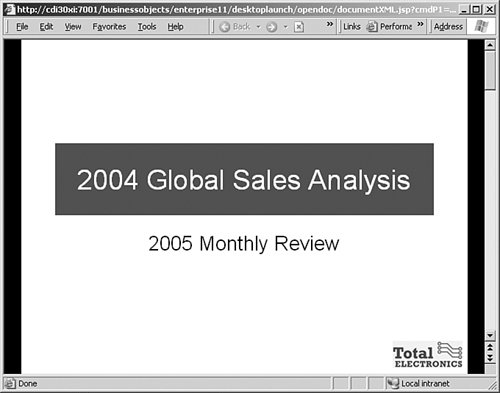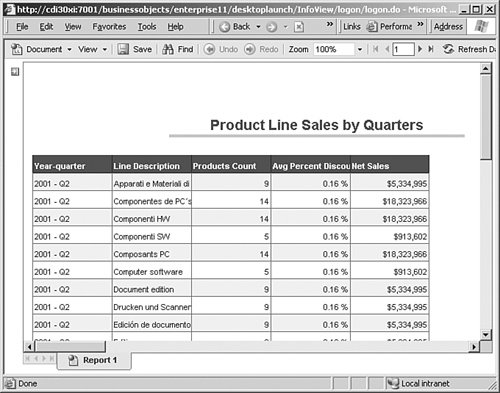Portal Integration Kits
| Business Intelligence is a natural complement to an intranet. Most companies today have implemented custom, open-source, or commercial portals that provide a security, navigation, and layout framework for presenting corporate information assets. Products include Microsoft SharePoint, Apache Jetspeed, OpenText Livelink, and namesake portal servers by IBM, Vignette, Plumtree, BEA, SAP, and Oracle, to name but a few. For many years, every portal product had their own API for creating, managing, and communicating between blocks in the portal, often referred to as portlets. In Microsoft SharePoint, these are called web parts. In SAP portals, they are iViews. Recently, Java vendors have coalesced around the JSR 168 standard that permits vendors such as Business Objects to write a single portlet implementation and deploy it in a wide variety of portal products. Business Objects has been producing portal integration kits (PIKs) for many years. On the Crystal side, the first portlets were web parts developed for Microsoft SharePoint by Crystal veteran Craig Chaplin. The next generation of Business Objects PIKs is modeled on the SharePoint integration and supports the JSR-168 specification. Functionality, partially shown in the following screenshots, includes preference integration; folder browsing and management; scheduling; inbox; favorites ("subscriptions"); and personalized, parameterized viewing of Crystal Reports, Web Intelligence documents, and managed Microsoft Office/PDF files. On-report parameter support is better implemented than in the core product itself and linking between portlets on the same page (interportlet communication) is fully supported. Light customization is possible through style sheets. Users can customize foreground and background colors themselves. If major changes are required, you can start from scratch or dig into the (somewhat complex) source code. Note Notably, security integration is not implemented in the JSR-168 PIK. You must present the logon portlet form to your users before the other portlets will work. In many cases, this is a show-stopper for using Business Objects portlets. Many customers choose to write their own portlets using the SDK, as shown in the previous chapter. Also, WebI documents are not shown in-line like in Crystal Reports; rather, they are popped up and leverage the openDocument.jsp handler described earlier in this chapter. You can preview the JSR-168 portlets in the following figures below. Figure 31.18 shows navigating through the folder hierarchy and listing the reports within. Clicking on Subscribe adds a report to your personal favorites. Figure 31.18. The JSR-168 Repository Browser portlet. Figure 31.19 shows how the various types of objects are surfaced through the portlet and shown through a pop-up windowin this case, a Microsoft PowerPoint document. Figure 31.19. The JSR-168 Viewer portlet, showing a hosted Microsoft Powerpoint document. Figure 31.20 shows a Crystal Report viewer and Figure 31.21 shows a WebI document. Figure 31.20. The JSR-168 Viewer portlet, showing a Crystal Report. Figure 31.21. The JSR-168 Viewer portlet, showing a WebI document. On Java platforms, portlets are packaged in a WAR archive. Instructions for configuring the BusinessObjectsPortlets.war file are provided for BEA, IBM, and Oracle application servers and IDEs in the Business Objects XI Portal Integration Kit documentation. You will be able to deploy the portlets on other J2EE application servers as well by following the methodology in the documentation. SAP PortalsBusiness Objects has invested tremendous resources in making its product stack the pre-eminent platform for business intelligence on SAP R/3 and BW. Crystal Reports, Web Intelligence, OLAP Intelligence, and Data Integrator all have native connectors for SAP that reduce the need for ABAP and BAPI programmers. SAP co-developed several of the solutions and bundles solely Business Objects BI products with their software. Additionally, should you want more than a limited license to the tool, SAP itself is an authorized Business Objects reseller. Business Objects ships a collection of cross-platform iViews that deeply integrate with SAP security and provide similar capabilities as the JSR-168 portlet implementation. These iViews permit tight and fast integration of production reports, ad hoc query, and guided analysis with your SAP portal (see Figure 31.22). Figure 31.22. The SAP PIK, viewing a Web Intelligence document. More than 100 predefined reports are shipped with the SAP solution kit and there is a wizard-driven install on the Business Objects SAP BW CD-ROMs. For more information on SAP integration, please visit www.businessobjects-sap.com. |
EAN: 2147483647
Pages: 365